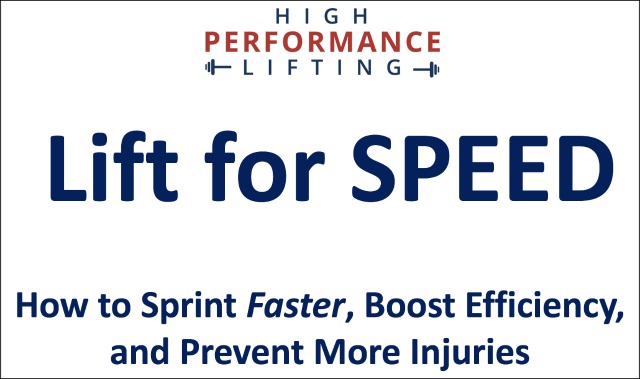Power training is not something I thought about as a young endurance runner. I want endurance, not power… right?
There are many endurance runners who don’t think they need to be powerful. After all, most of what we do is simply run for a long time. So why is power needed?
Well, it’s helpful to think about the end of a race like the mile, 5k, or 10k. If you’ve run one of these races, you know that the final 400-800 meters is particularly difficult when your lungs are burning, your legs feel like they’re on fire, and you just want to give up.
How do those professional runners manage such a strong finishing kick? How can they so powerfully finish strong?
A big reason for this impressive physical skill is their ability to produce power (even when highly fatigued). All of us would love to turn on the afterburners and sprint to the finish line. That feeling is far superior to a slow, positive split that leaves you feeling uninspired…
First, let’s make sure we understand exactly what we’re talking about so you know exactly how to focus on power training in your running program.
What is Power Training?
Let’s begin with a definition. What is power?
Power is the rate at which work is done. It is calculated by dividing work by time. When I took the USA Track & Field coaching course, we understood power to be a combination of strength and speed (therefore, it’s not a basic physical skill but a combination of two other skills).
In exercise science, power is often used to measure the performance of athletes. For example, a sprinter’s power output can be used to predict their speed.
Power is also important for everyday activities such as walking, running, and lifting objects. The more power you have, the more efficient you will be at these activities.
So if power is work divided by time, we understand that speed is a big component of power. If you can do the same amount of work more quickly, you’re more powerful than someone who can’t do the same amount of work in a slower time.
“Work” can be anything:
- running a mile
- lifting 100 pounds
- swimming 100 yards
So a runner who’s capable of a 5:30 mile is more powerful than a runner who’s capable of a 6:00 mile (it’s the same amount of work but it’s just completed more quickly).
Clearly, power helps us run faster. So how can we become more powerful?
How Runners Can Train Power
There are a number of ways to improve your power output that we’ll put into three categories:
- Running-specific training (not technically power training)
- Weight training (can be considered power training)
- Plyometrics (definitely power training)
While all of these training strategies help you become a more powerful runner, they all deliver results through different mechanisms.
In a perfect world, you’ll focus on all three to be the best runner you can be.
Run Specific Power Training
You can build power by just running. Seriously, it’s true!
Just by increasing your mileage, you’re improving your body’s ability to produce power. You’ll grow more mitochondria in each muscle cell (these are little factories that produce energy for work), improve your ability to buffer lactate (so you can run faster without needing to slow down), and strengthen muscles, connective tissues, and bone.
As you fatigue throughout the week (and during specific runs, like a long run), more muscle fibers will be recruited to complete the task of running. And training our ability to recruit more motor units (muscle fibers), will help us get faster.
Over time, these physiological adaptations make us more capable at running faster races.
Runners can also run strides (on flat ground or up a hill) or more formal hill sprints. These short but very fast efforts force you to recruit a lot of muscle fibers and improve your top end speed.
Do all of these things consistently and you’ll become a more powerful runner.
Strength Training Can Increase Power
Strength training is a more direct, albeit less specific tactic, for increasing power.
It works through three distinct mechanisms:
- Increasing muscle mass. Muscle mass is directly related to power output. The more muscle mass you have, the more force you can generate.
- Increasing muscle fiber recruitment. Strength training helps to recruit more muscle fibers, which can also increase power output.
- Improving neuromuscular coordination. Strength training helps to improve the coordination between your muscles, which can also lead to increased power output.
And of course, some exercises are better than others. And some strength training approaches are more beneficial than others.
Focus on multi-joint, compound exercises like the squat and deadlift. Lift heavy for 4-10 repetitions (rather than more reps at a lower weight). Specific power training exercises, like a Power Clean, can be particularly helpful:
This is three-time US Mountain Runner of the Year Addie Bracy completing a power clean exercise.
Follow these steps:
- Stand with bar hanging in front of the body, resting on the upper-mid thigh. Grip the bar with the clean grip (with hook grip preferred)
- Feet are hip width or slightly wider (use your best “jumping stance”). Stand tall, at attention, take a breath and lift the chest, keeping the back straight and strong and core tight.
- Bend the knees 4-6” (Power Position) keeping the torso as vertical as possible with your balance midfoot but slightly towards the heels.
- Immediately and explosively straighten the knees (jump, but jump with the
heels down as long as possible). - Now pull on the bar, fists next to the body, whipping the elbows and spinning the bar into the front squat rack position.
- As you whip the elbows, simultaneously rebend the hips and knees to receive the bar in a slight 4-6” squat.
- Recover to standing and carefully lower bar back to mid thigh to perform another rep.
Runners can perform movements like a Power Clean to increase explosiveness and power output.
Plyometrics Boost Power
Plyometrics may be the most direct and running-specific form of power training that exists.
Plyometrics use explosive movements to improve power and athletic performance. Plyometric exercises involve contracting a muscle immediately after it has been stretched. This causes the muscle to generate more force than it would if it were not stretched.
Examples include:
- Jumping jacks
- Squat jumps
- Lunge jumps
- Box jumps
- Depth jumps
- Medicine ball throws
Plyometric exercises should be performed with caution, as they can increase the risk of injury. It is important to start slowly and gradually increase the intensity of your workouts over time.
Because of their injury risk, I only include plyometrics in High Performance Lifting where they are expertly programmed by a USA Weightlifting national coach.
Is Power Training an Injury Risk?
Traditional power training involves moving objects with great speed and force (like your body or a weighted barbell). It is a great way to build strength, speed, and power, but it also carries an enhanced risk of injury compared to running or strength training.
The most common injuries associated with power training are muscle strains and joint sprains. Muscle strains occur when a muscle is stretched beyond its limits, while joint sprains occur when a ligament is stretched or torn.
These injuries can occur when you are strength training with weights that are too heavy, when you are doing exercises that you are not familiar with, or if you have improper form (a common mistake with plyometrics).
Other injuries that can occur with power training include:
- Tendonitis: This is an inflammation of a tendon, which is a band of tissue that connects muscle to bone.
- Bursitis: This is an inflammation of a bursa, which is a small sac of fluid that helps to cushion joints.
- Stress fractures: These are small cracks in the bones that can occur due to repetitive stress.
It is important to warm up before doing any power training exercises and to cool down afterwards. You should also listen to your body and rest when you need to.
Power Training: A Complete System
Power training has the potential to make you into a more robust, injury resilient, and faster runner. But it’s important not to do too much power training – it has serious injury risks and our energy as runners is best reserved for more running!
It also leaves us with a lot of questions:
- What exercises prepare you for explosive lifts like the Power Clean?
- Should explosive lifts be done early in a training cycle? (hint: no!)
- How are plyometrics like box jumps added into the training?
If you’re interested in ALL of the pieces to the strength puzzle – so you can build the power and strength to race faster – I’ve got great news.
Sign up here and I’ll walk you through all of the details of elite-level strength training.

Register here and you can expect to learn even more mistakes that you should avoid and the exact lifting schedule that produces powerful, race-ready runners.
If you’re ready to take your running more seriously this year and are ready to take the next step, you won’t want to miss this.
After you sign up, I want to challenge you to do just ONE THING in the next 5 minutes: commit to focusing on becoming more powerful.
Tell your partner. Shout it from the rooftops. Join a gym. Tattoo it on your thigh. Whatever it takes.
Weightlifting – and especially power training – can be transformational for endurance runners.
